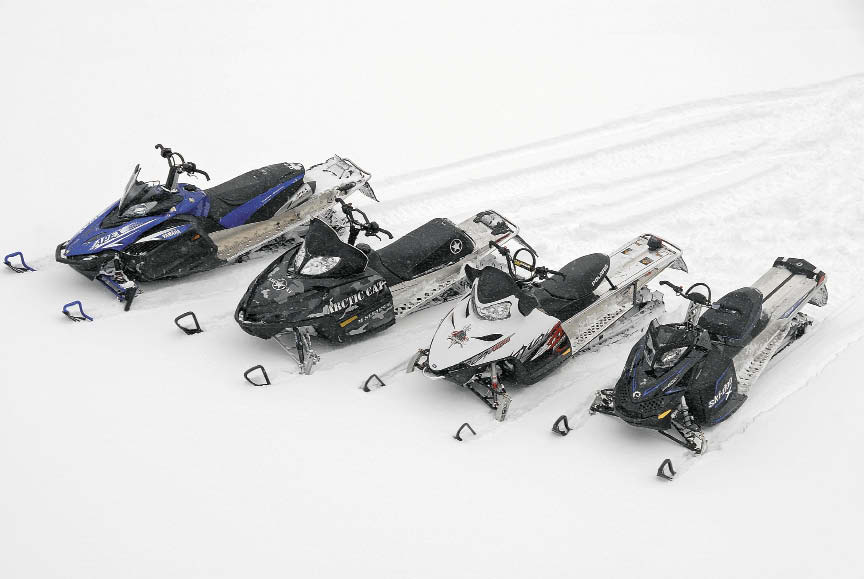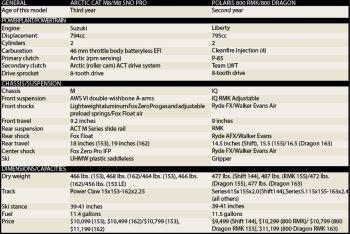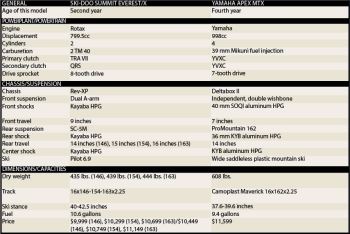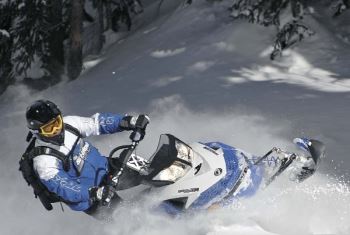 Usually it's easy to spend a couple months riding the new snowmobiles in the spring, sift through the technical info and scratchy notes over the summer and come away knowing which sled is the class leader.
Usually it's easy to spend a couple months riding the new snowmobiles in the spring, sift through the technical info and scratchy notes over the summer and come away knowing which sled is the class leader.
Not so with the 2009 lineup of 800 class mountain sleds.
First, you have the Arctic Cat M8, which went into the re-vamp machine and came out the other side 22 lbs. lighter and more functional than ever.
Then you have Polaris with the proven 800 RMK line that got its share of upgrades and improvements, netting a 15-pound weight reduction on the 800 Dragon RMK.
The super-light Summit 800 returns with improvements to reliability that should make it a solid sled for another outstanding season.
And the Yamaha Apex MTX, a proven four-stroke with a loyal following, is back for another season.
But picking a clear-cut winner from this crop is harder than signing the financing forms for the hefty prices they each command.
But we did our job, giving each 2009 800 class mountain sled a thorough evaluation and examination, asking the tough questions that are on every mountain rider's mind.
2009 ARCTIC CAT M8
What does Cat offer for '09?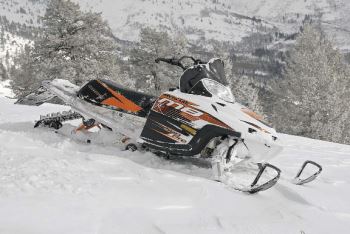
Arctic Cat's popular M8 returns for another year, although the 2009 model is heavily updated and significantly lighter than the 2008 model. The 2009 M8 has lost 22 lbs. of mass, bringing its weight numbers down closer to those of the Summit XP's. There are three versions of the M8 and two are available any time of the year (M8 standard and M8 Sno Pro). The Sno Pro LE is a spring-only version. The base M8 is available in two track lengths-153 and 162. So is the M8 Sno Pro version. The LE is only available with a 153. There are more significant differences between the 2009 M8 and M8 Sno Pro than in previous years. Only the Sno Pro gets the Fox Float shocks up front, the premium digital/analog gauge and the new telescopic steering post system. The LE gets all of that plus a titanium drive clutch spring and a Boss seat.
What has changed since last year's M8?
The Arctic Cat M8 has the longest list in the class:
ACER. Arctic Cat Engine Reverse debuts on the 2009 M8, both versions. This is the same technology shared by Ski-Doo (RER) and Polaris (PERC) where the engine's rotation is reversed to make the drive train turn in reverse. It's about 10 lbs. lighter than last year's mechanical reverse.
Power Claw. The new track that sits under the M8 and M8 Sno Pro is all-new. Its design incorporates aspects of the Attack 20 track and the Camoplast Finger track. The Power Claw's lugs are wide and tilted back. On the outside edges of the lugs, just above the track clips, stand 2.25-inch tall, firm towers that bite into anything that the wide lugs won't. The design also creates a cup that shovels the loose powder under the sled, maximizing flotation. The 15-inch wide Power Claw is standard on all M8s.
Telescopic steering column. A design that was originated by Jason Howell a few years back, the M8's telescopic steering system allows the rider to adjust the height of the handlebars over a 4.5-inch range, with 3/8-inch increments. It takes just one hand to make the adjustment and the system is no heavier than a 2-inch aftermarket riser block. The telescopic steering column is only available on the Sno Pro.
Running boards. One of the M8's flaws in the past was that its long running boards would hang up in deep snow, preventing the track from digging down to better traction. The 2009 M8's running boards no longer run the full length of the tunnel, instead ending at the rear of the seat and tying back into the tunnel for support. This, along with a more aggressively tapered tunnel, lets the Power Claw track do its job.
Float skid. Call it Float 2.0 if you want, because the '09 M8's rear suspension features a Fox Float rear track shock with a Fox Zero Pro coil-over gas shock on the front arm, surrounded by all-new slide rails and a few other improvements. It adds up to a 3.5-pound weight reduction over last year's rear suspension.
Rear bumper, taillight and snow flap. The 2009 M8 features a lighter rear bumper and tunnel close-off assembly than the `08 and the new design is much more durable and the LED taillight is more visible than before.
Narrower bars. The 2009 M8's handlebars are one inch narrower (half an inch taken off of each side) for better maneuverability in the trees.
Boss seat. If you ordered early (last April) you had the chance to opt for a lightweight Boss Hi-Rise seat, saving you another 8 lbs.
What does it weigh?
Arctic Cat publishes both dry sled weights and crated weights. Dry weights are the sum of every part that makes up the sled without any lubricant or fluid. Crated weight is what you would see if you removed a new sled from the shipping crate and weighed it. Crated weights show lubricants, coolant, a small amount of injection oil and gasoline. Each of the other manufacturers list dry weight.
The 2009 M8 dry weights are:
M8 153: 466 lbs.; M8 162: 468 lbs.; M8 153 Sno Pro: 464 lbs.; M8 162 Sno Pro: 466 lbs.; M8 153 Sno Pro LE: 456 lbs.
What is the engine like?
The M8's twin-cylinder laydown Suzuki two-stroke engine may not have the peak horsepower numbers of the other sleds in the class, but its power delivery is as smooth as butter and throttle response is crisp and solid.
The engine is 794ccs with a bore and stroke of 85mm by 70mm. It features APV variable exhaust valves with a single tuned pipe. Arctic Cat rates the M8's engine at 148 hp.
Our staff's test riders were impressed overall with the M8's engine, stating that it is a "stout and a good performer," and "not the strongest 800, but definitely capable and smooth."
How good is the chassis?
Excellent, especially considering the 2008 M8 chassis. Arctic Cat's engineers did an excellent job researching the M8's weak points and developing solid cures for the 2009 version. The changes to the rear of the tunnel and the new running board design make this chassis work where the previous version floundered. The 2009 M8 chassis is designed to work as a package with the new track, lighter suspension and updated geometry. The aggressive track can get down to the settled snow that's often found two feet or more beneath the surface layer. It can do it because of the new tunnel taper and shorter running boards.
What tracks can you get?
One track, two lengths. But it's possibly the best mountain track on the snow. The 15- by 153- or 162-inch Power Claw is a multi-functional, do-it-all track. It cups deep, loose powder and holds it under the track rather than spitting it out the sides. The wide, negative angle lugs take large swaths of snow for maximum propulsion. When the snow settles and the lugs slip, the tall, hard-durometer towers that are strategically placed beneath the slide rails for maximum penetration bite, claw and grab at anything in their paths. The Power Claw is a phenomenal mountain track.
How good are the skis?
Average. But that means they do everything well and nothing horribly. The only drawback to the M8's skis is that the Power Claw track may overpower the skis, which were originally designed to run with the forgiving Attack 20 track. A more aggressive ski might be in order, but it's always a compromise. Go for more bite and you give up a little of the forgiving handling offered by this ski.
How good is the suspension?
Let's put it this way: it's light. If you're after a mountain sled that can take you deep into the backcountry over miles of untracked powder, then light is what you want. But deep moguls or sharp stutter bumps that are often found on a backcountry ride are not the M8's suspension forte. The '09 M8 is better at handling the bumps than previous years, thanks to improved suspension design and shock valving. The Floats are good for most everything, but air compresses at a progressive rate, making it nearly impossible to utilize the full stroke in big holes.
One test rider noted that the M8's ride is "much improved overall and more predictable," while another wrote, "Still work to be done in the big bumps, but better than it used to be."
What we didn't like:
Here's what we could live without on the 2009 M8:
Seat. We don't understand why, after doing so much to cut weight off of the `09s, Cat left the stock seat alone. On top of that, the design is dated. The Boss seat that you could get on spring orders is 8 lbs. lighter. If you ordered early and got a Boss, great. But the rest of you are not so lucky.
Shock rebound: The rear suspension kicks a little too much, mostly because of the Float's natural characteristics. We would love to see Float R Evols on this sled.
Skis. We don't hate the M8's skis, but we'd like to see an improved design to complement the Power Claw track.
White Sno Pro front bumper. We're tree riders. We turned the white front bumpers on every '09 M8 Sno Pro we rode last year a nice shade of brown, sap and greasy black handprints.
What we liked:
Here's what we love about the 2009 M8 (it's a long list):
Off-trail handling. This sled is all about flowing with the rider. There is no downside to how the M8 handles when sidehilling, carving through trees, rolling through deep powder or working your way up a ridgeline. The M8 is predictable, reliable and capable. One test rider said of the M8's off trail handling: "Edges out the Polaris for best-in-class."
Running boards. One test rider says the '09 M8's boards are "currently the best design in the industry." We'll leave it at that.
Telescopic steering column. What a great idea. We like it because we can have four or more riders on one sled in one day. This setup makes that sled fit each of those riders with a simple adjustment. On top of that, there are different conditions that demand different rider ergos. The M8 Sno Pro covers all of them.
Throttle pull. Cat's batteryless EFI has smooth, easy throttle pull with crisp throttle response.
Power Claw track. We didn't think track design could take such a large step forward. It did. "This is THE track in the mountains," said one test rider.
Weight. As in reduction. The M8 is 22 lbs. lighter. The M8 Sno Pro is lighter still with Float shocks. The M8 Sno Pro LE is more than 30 lbs. lighter with the Floats and Boss seat. We knew it was there. Cat found it.
Reliability. We had engine issues with two of our 800-class sleds last season. The M8? Not a single problem. Same engine for '09.
LED Taillight. Seeing the taillight of the sled in front of you is difficult when the sled is throwing up so much snow dust. The LED taillight is visible through it all.
Rear skid. We love the look of the new rails. It only helps that they're stronger and lighter. The two-wheel rear axle allows the track to flex and bend on sidehills for even more traction. Everything about it is solid engineering.
What's the bottom line?
The 2009 M8 is a title contender. It may be a bit underpowered compared to the RMK 800 and slightly overweight compared to the Summit XP, but its rideability makes up the difference. The improvements to the M8 make the 2009 line of 800 mountain sleds the most closely competitive class ever. But you cannot go wrong with putting one of these in your trailer this season.
2009 POLARIS 800 RMK
What does Polaris offer for '09?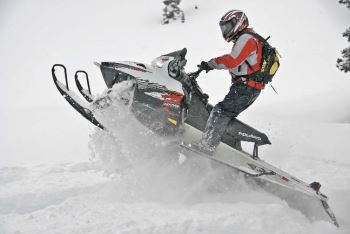
For 2009, there are five different versions of the Polaris 800 RMK to choose from. They are 800 RMK Shift with a 144 track, 800 RMK Assault with a 43-inch front stance and 146-inch track, 800 RMK 155, 800 Dragon RMK 155 and 800 Dragon RMK 163, which feature ProTaper handlebars and premium Walker Evans shocks. We'll focus on the base RMK and Dragon versions.
What's changed since last year's 800 RMK?
2009 was more of a refining process for the 800 RMKs. Yes, Polaris added the 800 Assault RMK and 800 RMK Shift, but the base RMK and the Dragon are mostly refined packages.
What's new on the base RMK and Dragon?
Nose pan. The nose pan assembly has been changed to a re-designed three-piece system that narrows the nose of the sled and reduces its drag through deep snow. The change opens up the front suspension wells and lets the body of the RMK float better. The improvements result in a better-handling deep snow sled, and significantly cheaper and easier repairs to the pan.
Front bumper. Keeping in line with the Raw chassis' theme, the plastic front bumper found on the '08 RMKs was scrapped for a much stronger aluminum front bumper that can actually take a hit with a flimsy tree or be yanked on by a burly fellow sledder. The new bumper and nose pan cut 3 lbs. off of the '09 RMK.
Lightweight spindles. The 800 RMKs feature new spindles that are machined for lighter weight. How much? Half a pound each. The lightweight spindles are not available on the RMK Shift.
Lightweight slide rails. The RMK's new slide rails are designed to be stronger and more durable than before and the changes resulted in a net weight savings of half a pound per rail.
Lightweight brake rotor. Rotating mass is critical to mountain sleds. By cutting one pound off of the '09 800 RMK's brake rotor, Polaris improved the sled's response and feel.
Magnesium chaincase cover. The 2009 800 RMK and Dragon feature new magnesium chaincase covers that are lighter and stronger.
ProTaper handlebars. Available only on the Dragon RMK and Assault RMK, the new Pro Taper handlebars are lighter, stronger and have a straighter bend to them. The Dragon's ProTapers feature a mountain strap; the Assault's bars do not.
What does it weigh?
Here's the Polaris published dry weights for the 2009 RMK 800s:
800 RMK Shift: 477 lbs.; 800 RMK Assault: 487 lbs.; 800 RMK 155: 487 lbs.; 800 Dragon RMK 155: 472 lbs.; 800 Dragon RMK 163: 477 lbs.
What is the engine like?
Powerful. The Cleanfire Injection 795cc Liberty twin makes 154 hp, putting it at the top of the class-even above the Apex MTX's four-cylinder four-stroke for peak horsepower. It's bore and stroke are 85mm by 70 mm. The Liberty 800 mil has four injectors, two per cylinder. On each cylinder, one injector hits the transfer ports and a second injector shoots the case.
On snow, the 800 produces a broad, usable powerband with lots of low-end torque and peak power that revs high. You can do a lot with the 800 RMK's engine, whether you're in waist-deep powder or climbing a nearly vertical line. The 800 Liberty twin is the class favorite among SnoWest test riders.
How good is the chassis?
The IQ RMK Raw chassis is a purpose-built mountain chassis stripped of all unnecessary add-ons. It's light and rigid. The running board design lets snow pass through them without too much ice buildup, although not as well as others in the class. The edge roll is extremely sturdy, withstanding the abuse that in the past has caused them to bow and bend.
We love the RMK's chassis for its lightweight feel in off-trail conditions, its solid, unfazed ride in rough terrain and its ability to float through deep snow.
What tracks can you get?
Polaris also improved the 800 RMK's track for 2009. The Series 5.1 track is 3 lbs. lighter and has a better lug layout to maximize its ability to move through deep snow. However, the Series 5.1 track is only on the base RMK and Dragon RMK.
There are four tracks that can be found under sleds with RMK on the hood. They are: 15x144x2 Series 4 (RMK Shift); 15x155x2.4 Series 5.1 (800 RMK and 800 Dragon RMK); 15x163x2.4 Series 5.1 (800 Dragon RMK); and the 15x146x2.125 competition track found only on the Assault RMK.
How good are the skis?
Outstanding. In fact, the Polaris Sidehiller 2 skis are the class favorite among SnoWest test riders: "Good all-around performer with foot traction on the top edges," and "Not many aftermarket skis can improve upon this OEM ski."
How good is the suspension?
There are three suspensions to discuss here. First, the 800 Dragon RMK: On big bumps, the Dragon's front and rear suspension are the best in class among test riders ("The best when compared to Ski-Doo and Cat"). Small bumps are no different. Polaris has found the recipe for an all-around suspension and perfected it like Rachel Ray. For a mountain sled that gets ridden on stutter bumps, moguls, deep snow and hard pack, you can't beat the Dragon RMK's suspension. Most of that ride quality is attributed to the Walker Evans shocks and countless hours of shock tuning by the RMK engineering staff.
The base RMK does not have the Walker Evans shocks and does not share the same ride quality. But it's here where you see that geometry is the other reason the RMKs handle so well. Even with base shocks under it, the 800 RMK absorbs most of what's thrown at it without unsettling the rider.
The Assault RMK is in a class of its own when it comes to suspension. It's not even on the same page as the Dragon RMK. The Assault's piggyback remote reservoir Walker Evans shocks are race equipment and are meant for pro-level aggressive riding. Not the kind of riding where you stand up and cruise through moguls rather than sit through them: the kind of riding where you pin the throttle and blitz through moguls like James Stewart at Millville. The Assault's suspension rewards abusive riding. However, for most RMK consumers, it may be more than they're looking for.
What we didn't like:
What's not to like on the 2009 800 RMKs? It's a short list:
Windshield. We never get through January without breaking or bending the side fairings of the stock RMK windshield. It looks good, but it's just begging for a tree branch.
Running boards. Snow builds up easier on the RMK's boards than the other brands. Bigger openings could help. We would also like more traction on them.
Hifax. We wore through a set of hifax-with ice scratchers deployed-before we had broken in the engine last season. There has to be better technology available.
Deep snow mobility. It's not that it's bad at climbing uphill through deep snow, it's just that it's now playing catch up to the Summit and M8 in this department.
What we liked:
What do we think makes the RMK a contender? It's a long list. Here are the highlights:
All-around handling. No other 800 shares the do-it-all capabilities of the RMK. It rails down rough trials, cruises through harsh moguls, carves through powder, floats through tree lines and climbs like a plane.
Stability. It's a stable chassis when you're depending on it but surprisingly nimble and flickable when you want it to be.
Suspension. The Dragon RMK is at the top of the class of any suspension discussion.
ProTaper handlebars. One test rider said, "An excellent setup, great width and love the hooks." Another said, "I like the ProTaper better than the base RMK's bars."
Seat. Again, we turn to the test riders, who said, "The best seat of any mountain sled. Height, width, firmness are all perfect. Excellent design."
Track. The Series 5.1 is a noticeable improvement over last year's Series 5 track.
What's the bottom line?
Almost all of our test riders had the same thing to say of the 800 RMK: It makes you a better rider because it inspires confidence. The chassis is predictable, the power delivery is smooth, the ride is plush and the handling is spot-on. Beginner, novice or pro, the RMK is a weapon in anyone's trailer.
2009 SKI-DOO SUMMIT 800
What does Ski-Doo offer for '09?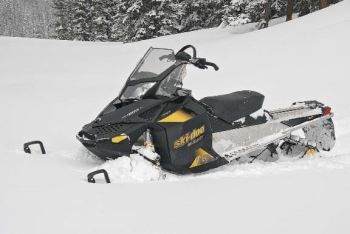
Want to buy a 2009 Ski-Doo Summit 800? All Summit 800s are built on the Rev XP chassis. For 2009, you can pick from the Summit Everest, which is the base model Summit with either a 146-, 154- or 163-inch track length, all 16 inches wide. If you planned early or are watching the classifieds, you might also choose from a Summit X, which is offered in the same three track lengths. With the X package, you also get the upgraded Brembo Racing brake with braided steel lines (Everest models have the standard Brembo hydraulic brake). You also get a lighter sled, thanks to lighter front suspension components, Kayaba HPG rebuildable aluminum shocks and the Rev XP racing seat. The X's gauge is an upgrade, too, to a multi-function digital unit with features like an altimeter. All Summit 800s get Rotax Engine Reverse (RER).
What has changed since last year's Summit 800?
Ski-Doo released a new drive belt for the 800R Summits (#417300377). It is 4mm shorter and 1mm wider for a better fit in the clutch sheaves. It will last longer thanks to the dimension changes and new compound that resists delamination and cord pullout.
There are new materials in the bushing and roller in the TRA drive clutch for increased life.
The secondary has a new drive ramp and 43/47 variable degree helix that gives a more linear load curve to eliminate the variation in high rpm engine operation. This change also lowers belt operating temperatures.
The secondary clutch's QRS adjuster (that thing you fought with while changing belts last year) has been totally redesigned for '09. The new locking mechanism is not affected by changes in temperature. The plastic bushing has much deeper holes in it so that the adjusting tool won't slip out of it. The design allows both the adjustment tool and a socket to be used simultaneously and the bolt head is now a 13mm to accept the standard socket in the tool kit.
The clutch guard is easier to remove and replace.
The hydroformed driveshafts will have a more strict quality control procedure.
A one-inch open-cell foam filter inside a prefilter pushes against the hood for better closure.
What does it weigh?
Ski-Doo dry weights are as follows:
Everest 146: 435 lbs.; Everest 154: 439 lbs.; Everest 163: 444 lbs.; X 146: 425 lbs.; X 154: 429 lbs.; X 163: 434 lbs.
What is the engine like?
The Rotax 800R is one of the best mils in the class. Each of our staff test riders raved about its strength, crisp bottom end and torquey top end. What were the comments? "Very stout performance package," "Quick, strong bottom end," "Brute force power," "Very smooth throttle response, just that it's harder to pull (the throttle)." Which points out the 800R's weak spot when it comes to laying on the power. All three of the competitor's sleds are fuel-injected. The 800R still uses these things called carburetors, which are excellent at making reliable, quirk-free power, but require a sturdy thumb. But if we're talking power, the 800R is driving the conversation.
How good is the chassis?
Good. Almost too good. The Rev XP chassis, which is the evolution of the Rev platform for two-stroke Ski-Doo snowmobiles, is a dream on paper. It's unworldly light-the lightest in the class by far. It's rigid almost to a fault but durable as an I-beam. It features all of the goodies that mountain riders demand: open grated running boards with plenty of traction that end just behind the seat so that they don't hold the track up in deep snow, a rider-forward geometry that puts the rider over the engine, excellent engine cradling design and a tight taper on the end of the tunnel. What's unique about the Rev XP platform is that is uses the chassis itself to perform many of the sled's mechanical duties, like incorporating the chaincase into the tunnel.
The Rev XP chassis centralizes its mass and cradles the engine low-so low that it's almost a drawback. The Summit 800 is the lightest sled in the class, but sometimes sidehilling with a center of gravity this low will make you dispute that fact in your head.
What tracks can you get?
There are three track lengths to choose from (each 16 inches wide) and it doesn't matter if you are riding the in-season Everest or the "spring-only" X package. All three tracks-146, 154 and 163-are Powder Max tracks. The Powder Max is very light and very rigid. It's a good track for the lightweight Rev XP sled.
How good are the skis?
The Summit's Pilot 6.9 skis are good all-around skis. They work best in deep, dry powder. On hard pack snow, the 6.9 skis dart due to the aggressive design of the ski's keel. The Pilot 6.9 skis are excellent when it comes to sidehilling, though.
How good is the suspension?
The unanimous decision among test riders was that the X-package sled's suspension was excellent, but there was a big gap between it and the Everest's suspension ride quality. That is mostly due to the difference in shocks. The aluminum Kayaba HPG take-apart shocks on the X are race-ready shocks that are valved for more aggressive riding. The Everest's Kayaba HPG shocks are valved for much less aggressive riding and blow through their stroke. None of the test riders gave the Summit X or Everest very high marks over small bumps. The Summits seem to transfer the jitters to the rider more than the other sled. However, put the Summit X or Everest in big moguls, nasty holes or deep whoops and you'd think you're on a totally different sled. It can absorb the big hits and keep the sled level while doing it, thanks to its lower A-arm design. But the X takes the hits much better than the Everest.
What we didn't like:
Here's what we didn't like on the 2009 Summit 800:
Aluminum handlebars.They vibrate and don't hold the heat of the hand warmers like steel bars. But they're light and that's what Ski-Doo is after.
Steering. The Summit XP's steering has a return-to-zero trait to it that makes counter-steering into a sidehill more difficult than others. It also has a stiff feeling in tree riding.
Throttle pull. You get used to it when it's all you ride, but us EFI pansies know there's an easier way.
What we liked:
Seat. The Summit XP's seat is fantastic. For mountain riding, it's high enough to make the transition from sitting to standing very easy. It's shaped so that you don't catch your foot on it while jumping side-to-side. It's in just the right spot to leverage your leg against it.
Weight. We've always wondered what life would be like with a 150-horsepower, 430-pound mountain snowmobile. Now we know.
Flotation. Our SnoWest Deep Powder Challenge proved it: nothing floats through the deep stuff like the Summit XP.
What's the bottom line?
Ski-Doo made a statement last year when it released the 430-pound Summit XP. There was no reason to make huge changes to the West's best-selling snowmobile. The Summit 800 has its quirks that must be worked out between rider and sled, but it is a five-star mountain sled.
2009 YAMAHA APEX MTX
What does Yamaha offer for '09?
Yamaha is in the business of developing competitive four-stroke snowmobiles. To do that, it must focus on one class at a time. 2006 was the Apex's shining year. For 2009, it's pretty much the same sled. Competitive? Yes. Class leader? No. At one time, the Yamaha Apex Mountain was declared the best sled in the class. The Apex has not gotten worse since, in fact it's improved. But the competition is ahead of the curve.
For 2009, there is one version of the Apex MTX. It is available in two color packages: Yamaha blue-and-white and black with flame graphics.
What's changed since last year's Apex?
Here's what's changed on the 2009 Apex MTX:
Name. Last year, it was the Apex Mountain. This year, it's the easier-to-write Apex MTX.
Rear suspension shocks. The Apex MTX gets two new shocks for '09, both in the rear suspension. The aluminum HPG shocks resist fading better and feature new and improved shock valving for better bottoming resistance.
What does it weigh?
A lot. The 2009 Yamaha Apex MTX weighs in at a Yamaha-claimed 608 lbs. dry.
What is the engine like?
The overriding tone of the SnoWest staff's reports is that the engine is phenomenal; it's the weight that hurts it. If this sled were pulling weight figures closer to 500 lbs., the sled would be unstoppable. You simply can't have this much torque and not annihilate every mountain you point it at. The throttle response is instant and horsepower peaks at 151. It's a great engine that has worlds of potential.
How good is the chassis?
Aside from being heavy, the Apex MTX's chassis is great. It set the bar for rider-forward mountain geometry in '06 and maintains that excellent feel. You are perfectly positioned over the Apex MTX's mechanical parts, giving you maximum leverage to maneuver the sled. The running boards could use a little more strength to them and more of an open design to let snow fall through.
What tracks can you get?
Only one. The Maverick 16x162x2.25 track is an excellent track, perfectly matched to the engine's power output and the chassis flotation requirements. The Maverick flexes enough to paw gently through powder without trenching, yet grabs hard pack firmly enough to eliminate slip.
How good are the skis?
For the Apex-great. This sled demands an aggressive ski with maximum flotation. That description matches the Apex MTX's skis perfectly. As long as the Apex MTX is around, this is the right ski for it.
How good is the suspension?
Surprisingly good. On our day-long test rides last spring, anytime we would encounter long high-speed rough trails, the Apex MTX was the first sled spoken for. It has a plush ride and doesn't get tossed around. Yamaha has scored a hit with the Apex's ride and handling.
What we didn't like:
Weight, weight, weight. We really do like the Apex MTX, it's just that when you're riding in a group of sleds that are 150 lbs. lighter than yours, it's like you're carrying a passenger with you wherever you go. Yamaha built a lighter four-stroke performance sled in the Nytro with success; we'd like to see them revamp the Apex MTX.
Seat. The dimensions are fine, but the top material is too slick.
Windshield. The Apex MTX has no hand or body protection from the wind.
What we liked:
There's a lot to like about the 2009 Apex MTX:
Handlebars. The Apex's handlebars just fit. The grips are narrow enough that you don't have to adjust your hand position to utilize the bar hook. The bars are just the right width and the riser height tops it off.
Power. On a hard pack, this engine is a rocket ship. If you've never ridden a four-stroke like the Apex, you don't know what torque on a snowmobile is.
Handling. More because you'd never expect a 600-pound (694 lbs. full of fuel) sled to go through the snow like this. It's fun just to take the Apex into the hills for the experience.
Starting. Turn-key starts are sweet.
What's the bottom line?
The 2009 Apex MTX is riding it out. It was a major player (still is with the turbo crowd), but has not kept up with the evolution of the competition. A lighter chassis with this motor could be awfully dangerous to the competition. But for now, the Apex MTX is the biggest four-stroke you can do real mountain riding on.
How do we rate the 2009 800 class of mountain sleds overall?
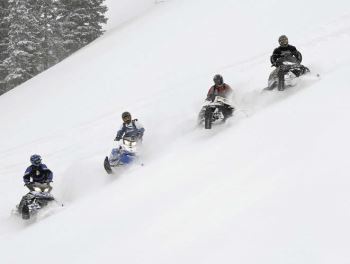 Most SnoWest test riders leaned towards the 2009 M8 Sno Pro. Maybe it's because it's so vastly improved over last year. But the M8 Sno Pro is a very capable, very threatening sled. The 800 Dragon RMK is still the class leader for all-around mountain riding, but the M8's ability to carve through the steep and deep miles from any reflector post (the true core of mountain riding) without wearing down the rider or requiring any special learning curve to operate sets it apart.
Most SnoWest test riders leaned towards the 2009 M8 Sno Pro. Maybe it's because it's so vastly improved over last year. But the M8 Sno Pro is a very capable, very threatening sled. The 800 Dragon RMK is still the class leader for all-around mountain riding, but the M8's ability to carve through the steep and deep miles from any reflector post (the true core of mountain riding) without wearing down the rider or requiring any special learning curve to operate sets it apart.
We struggle with the Summit XP. We give Ski-Doo all the accolades in the world for developing such a lightweight snowmobile. It has a power-to-weight ratio that is unmatched in modern snowmobile design. It ought to dominate the western mountains. And for many riders it does (there's a reason it was the top-selling mountain sled in the West last season). The Summit requires a special form of riding that only one of the five SnoWest test riders is 100 percent comfortable with (and the rest of us think he's faking it). If it's our fault that we can't ride the Summit XP with the ease we find on the RMK and M8, we'll accept that and let you know when we figure it out. But understand that this season's 800 class is the tightest, most competitive class we've tested in years. Usually, we can spot the class leader early on in the testing season and let the others fall where they may. But the gap between the M8, RMK, Summit and Apex MTX is miniscule.
The Summit is the lightest, the RMK the most consistent and the Yamaha most reliable. But we're betting the most-improved M8 turns a lot of heads on the slopes this season.
